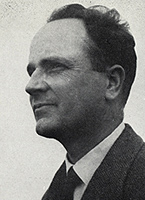
 Georges Goetz was born on August 30, 1910, in Paris. His father, a wood sculptor, ran a significant workshop in the suburb where Georges received his early training. This education not only destined him for the Boulle School, where he was part of the same promotion as Maxime Old, Jean Lesage, and Sébastien but also exposed him to a particularly cultured environment that familiarized him with museums and art history.
Georges Goetz was born on August 30, 1910, in Paris. His father, a wood sculptor, ran a significant workshop in the suburb where Georges received his early training. This education not only destined him for the Boulle School, where he was part of the same promotion as Maxime Old, Jean Lesage, and Sébastien but also exposed him to a particularly cultured environment that familiarized him with museums and art history.
He studied archaeology at the Louvre School and ethnology, becoming one of the founders of the Society of Oceanists, headquartered at the Museum of Man. He collaborated with René Prou, Francis Jourdain, and Albert Guénot before establishing himself independently after the Liberation.
Since 1930, he participated in the Salon des Artistes Décorateurs, where he received plaques from the Society of Encouragement for Art and Industry. He was awarded a gold medal at the 1937 Exhibition.
As a member of the Committee and Board of Directors of U.A.D.C.E., Georges Goetz was appointed a professor at the School of Applied Arts in 1946. Besides private projects, the Mobilier National entrusted him with significant works, including the Commission Room of the Direction des Arts et Lettres, the Mobilier National of Alsace and Lorraine, the office of Marshal Juin at Les Invalides, and the reception salon of the Cabinet of the Minister of P.T.T. He also designed and decorated the office of the CEO of the Compagnie Transatlantique, the conference room of Laboratoires Spécia, and the dining room of the CEO of Régie Renault.
From his initial training in his father's workshop, Georges Goetz developed a taste for wood and intellectual curiosity, which led him to explore diverse fields through constant interaction with specialized artisans and cultivated individuals. His apprenticeships with decorators, especially Francis Jourdain, significantly influenced his aesthetic convictions.
However, his initial commissions from the Mobilier National, which required adapting to specific settings, limited his ability to express his attraction to more resolutely modern forms. While he occasionally had the freedom to do so and, among other things, created an excellent seating model exhibited in "Formes Utiles," it is in his teaching rather than in his practice that he takes pleasure in disseminating the principles he holds dear and strives to instill in his students.
He remains loyal to wood, particularly to natural state woods from the region, which he skillfully works as a sculptor, seeking the expressive value of volume. Drawing from the examples set by Francis Jourdain, he advocates for a fundamental honesty when confronting all problems and emphasizes respect for tradition in spirit rather than form.
He believes that necessary rationalism should not be merely theoretical: furniture designed for humans should adapt, without strictness, to their habits, needs, and all aspects of daily life.
Georges Goetz also believes that mastering the craft should be accompanied by a strong general culture, preferable to narrow specialization. Artisans must free themselves from their benches to create meaningful works. He believes that well-prepared young individuals are more than capable of contributing to the creation of today's style. Georges Goetz met Valentine Lemahieuw at the School of Applied Arts, where she taught Industrial Design. From 1968, he taught for ten years at the Beaux Arts and in Architecture, where he had worked on preparing reforms, at the UP5 unit in Nanterre, where he opened a sculpture workshop, and in an option for Restoration and Rehabilitation of Old Buildings, which prepared students for the Chaillot School.
He dedicated his retirement to painting.
He passed away in March 2001.
Photo : D. Georget / Hst " Monstres Pensifs ", Document fourni par la Famille de l'Artiste